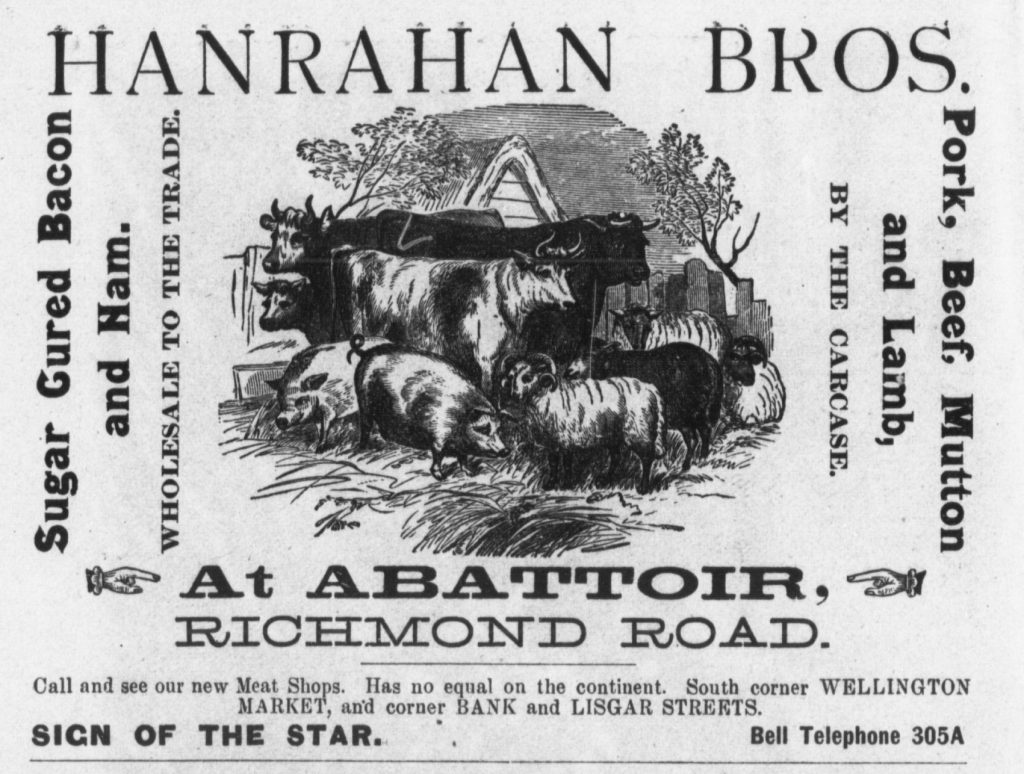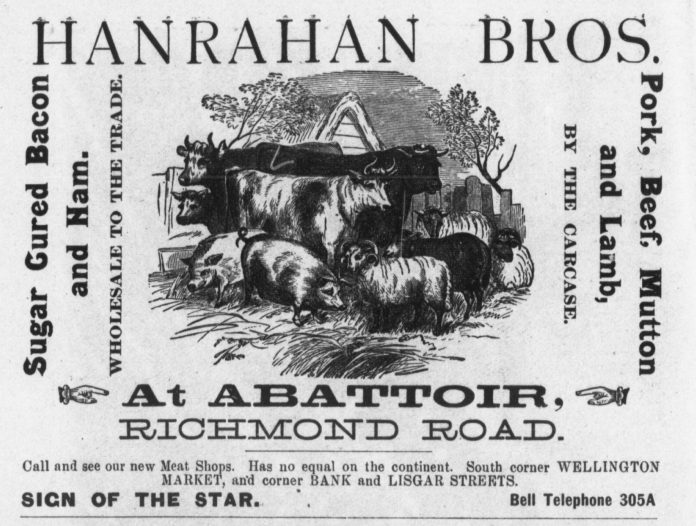Hintonburg was still just a tiny, growing hamlet in 1878 when butcher Joseph Hanrahan arrived, full of dreams and aspirations. He was a 30-year old budding genius, a visionary who had been around meat since birth, who foresaw the benefits of growing the family butchery business outside the city limits.
It was during those early days in Hintonburg where Joseph would develop and trial many inventions which eventually would revolutionize refrigeration and the transport of perishable food. His name and contributions have been long forgotten, but he played a key role in changing early Hintonburg, and his work would literally change the world.
The Hanrahan family first arrived in Bytown in 1847, getting into the butcher business right away. Catherine Hanrahan was a widow in her 50s who opened a ‘victualler’ stall in the market, along with her two sons, who eventually took over the business. Her grandson, Joseph was born in May 1848, not long after the family’s arrival in the city. Over the next 86 years, he would lead an incredible life off the foundation established by his grandmother.
As his life’s work would show, Joseph had varied interests outside of the family butchery business. As a young man, he started working as a blacksmith for John and William Ahearn, older siblings of Thomas Ahearn – perhaps Ottawa’s most well-known inventor, who helped bring electricity and the streetcar network to Ottawa.
By 1875, Joseph had returned to the butchery business, opening the firm “Hanrahan Brothers” with his brothers Thomas and Timothy in LeBreton Flats at a “beef stall” by the entrance to Pooley’s Bridge. Later they would settle into more permanent locations at the Wellington Ward Market (corner of Sparks and Lyon) and in a shop at 166 Sparks Street.
The operation of a butchery at the time was complicated. Meat had to be sold very fresh, as refrigeration and storage methods were primitive. Thus butchers tended to keep their own livestock.
The Hanrahans smartly acquired two lots in Hintonburg on the north side of Wellington Street (then still called the Richmond Road), at first through a lease in 1878, but eventually through a purchase in 1882, and opened up a small shop and “pork packing” facility.
Operations in Hintonburg initially focused on the pork side of the business, which advertised “sugar cured bacon and hams, barrel pork, spare ribs, fresh pork, sausages, bologna sausages and everything in connection with the pork business.”
It was noted in December 1882 that Joseph, “with commendable enterprise,” had connected his pork packing business on Richmond Road with his Sparks Street branch via telephone, enabling orders from anywhere in the city.
The Hanrahans were not only butchers and pork packers, but also livestock dealers, travelling far and wide to acquire only the best animals for their firm. Soon they would expand, acquiring nine adjoining lots in Hintonburg to create a huge property several hundred feet wide.

Timothy Hanrahan provided a thorough tour to an Ottawa Citizen reporter in April of 1884, who described the modern, impressive facilities, including the ‘hog bin,’ the 40×24 foot cattle-killing room, stables, ice house, and weigh house (now the vacant lot at the southeast corner of Merton and Armstrong). The Hanrahan family resided in a home built on the property. Reports called the Hintonburg operations “beyond a doubt the best in the Dominion.”
Intriguing the reporter most of all was the new modern refrigerator. Said to be the “best planned refrigerator on the American continent,” he wrote that it was “able to keep meat for four months during the hottest days in summer and … turn it out for sale as tender and more choice than it was on the day it was killed. In the refrigerator there are over 2,000 pieces of ice piled on the top of each other some thirty feet in height.”
Operations were complex, but efficient and humane. Fifteen workers were employed at the Hintonburg plant, which aside from railways and mills, would have easily made it the area’s largest employer at the time.
The Hanrahans became known as “the Butcher Kings.” A visiting butcher from London, England stated the Hanrahans had the “best killed beef which he had ever seen anywhere in his life.”
The growth of the operations in Hintonburg was vast and quick, and while Timothy may have been an expert cattle buyer, it was Joseph who was the brains behind the operation. And he knew that solving the refrigeration and preservation question was the key to success.
Throughout the 1880s, he filed patents not only for inventions such as rock drills and garden sprinklers, but he began getting deeply into refrigerator systems, refrigerator buildings, and refrigeration cars for rail and ship travel. Over a dozen patents with complex schematics were filed for these and many other inventions, in both the U.S. and Canada. (Into his 80s in the 1930s, he was still submitting new plans for cold storage buildings, evaporators, drying kilns, fans, clothes drying facilities, oxygen chambers, and more modern refrigeration systems. It’s hard to imagine there was a more prolific inventor in Ottawa over this 50 year period.) Doubtless, many of his inventions were trialed at his Richmond Road abattoir.
His patent refrigerator was revolutionizing meat preservation across North America in the 1880s. He was called across the States to help manufacture more and more refrigerators, and in the fall of 1886, installed units on ocean steamers (the Sardinian, the Vancouver and the Oregon) to carry meat and fruit overseas,which was a game-changer. “In plain English, they have struck a bonanza,” trumpeted one report.
Joseph was proud of his innovation, as the refrigerators were constructed “on scientific principles,” and “can be made of any shape, design or size, thus placing them within the reach of rich and poor.”
That same fall of 1886, Joseph oversaw the opening of the Automatic Refrigerator Company, located at the corner of Lyon and Wellington, to manufacture his refrigerator units. Within a couple of years, Joseph sold his interests in the Ottawa companies and moved to the U.S. to focus on opening factories for his refrigerator car in centers like Detroit, Chicago and New York City.
His brother Tim Hanrahan took over the butchery in 1889, and renamed it the Hanrahan Meat Company. Perhaps he felt the business had outgrown the village. Hintonburg was still small but growing quickly. By this time, it was home to two grocers, two general stores, a fruit seller, baker, carriagemaker, grain elevator, flour mill, carpenter, and a blacksmith.
Tim found a new home on 40 acres of land, which is now the area north of Scott Street to the River, comprising Island Park Drive, Remic Avenue and Latchford Road. Then it was empty grassy fields, which made the perfect locale for a new slaughterhouse and stockyards. Further agreements were made for use of adjoining lands going west, giving Hanrahan plenty of space to build a new 110×22 foot main building, a 30×40 foot piggery, a 24×30 foot refrigerator, a 50×20 foot ice house, a 50×50 foot packing house, and a 20×20 foot “sausage room,” among other buildings.
In fall 1890, not long after opening, there were 390 cattle, 440 sheep, and 240 pigs on hand, plus hundreds of other animals being penned on farms to the west. It would have been an impressive operation in an isolated location.
Hanrahan not long after sold the property to fellow butcher Richard N. Bishop in 1891, though they likely had a shared usage agreement for the abattoir. In 1900, Robert H. Cowley purchased the property and later laid out a residential subdivision with his partner Francis R. Latchford. The old slaughterhouse buildings were abandoned, and years later there were stories of children in the vicinity finding quantities of old horse teeth while digging in the dirt.
Meanwhile in the early 1900s, Joseph Hanrahan was solving the universal problem of shipping perishable fruits. Previously, fruit dealers had to pay expensive express shipping fees for distant fruit, but Joseph’s new refrigerator cars allowed for fruit to be sent on ordinary freight charges and arrive in better condition. He received a contract from the provincial government for his cars. He also built a cold storage plant at the Ontario Agricultural College in Guelph.
Joseph later got into modernizing dry cleaning and drying facilities, said to be the most effective method of drying clothes yet seen. He used businesses such as Mason’s Mill in Hintonburg to test some of his designs. He continued inventing his entire life.
Joseph returned to Ottawa late in his life and passed away here in 1934.
